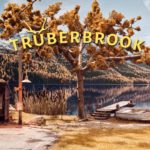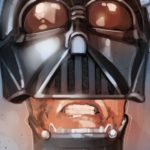TRÜBERBROOK
 Developer: btf
Developer: btf
Writer: Florian Köhne, Nils K. Müller
Voice Actors: Justin Beard (English): Dominik Wirth (German), Nora Tschirner, Dirk von Lowtzow
Publishers: Headup Games
Supported Platforms: Nintendo Switch, PlayStation 4, Xbox One, Microsoft OS, Mac OS, Linux OS
One of the things I love best about indie games is the capacity for experimentation. Indie developers make smaller games, throwing a lot of time and resources behind a concept that would be unfeasible on a larger scale. For Trüberbrook, the developers took the extraordinary step of creating scale models to make all the game’s backgrounds. From the beginning animation until the very end of the game, every set that you move around started as a painstakingly detailed physical model.

Set in the 1960s in the small German town of Trüberbrook, you play as Hans Tannhauser, a young American physicist who mysteriously wins a trip to the eponymous rural town. Once there, he starts to notice that there is something strange about this place and its inhabitants. Interacting with a cast of unique characters and strange locations, Tannhauser’s relaxing vacation soon turns into a quest to save the world.
This point-and-click mystery adventure is going for a Twin Peaks meets The X-Files vibe. They certainly have the right ingredients: enigmatic characters, a mysterious corporation, a creepy asylum, and parallel universes. However, that’s one of the game’s failings; Trüberbrook feels like it’s trying to use so many tropes that it’s not taking the time to really explore any of them.
There’s a whole section near the beginning where Tannhauser wakes up in a creepy asylum being asked strange questions by a sinister psychologist. It’s a game chapter that drags on with no real purpose, and once you escape the asylum, that’s it; it’s never really connected to any other part of the story. Other than to tick the “creepy asylum” box in a list of sci-fi tropes, why is it even there?
Each character and story element—indeed, the whole folklore of the town itself—seems to exist independent of every other aspect in the game. Some NPCs exist only to hand-feed you exposition that doesn’t really influence the story much, if at all. It misses the satisfaction of a unified mystery and ends up feeling disjointed. And while some aspects of the world were definitely trying to be creepy, it missed the mark on giving me true chills the way games like Gone Home (2013) and Oxenfree (2016) did.

Of course, the way Trüberbrook really shines is its unique graphic style. After being built by expert model makers and artists, the models were digitized using photogrammetry, then simplified for real-time rendering. Each model was digitized multiple times using different lighting to account for different times of day and seasons (snow scenes even included tiny fake snowflakes). The characters were designed to look like models in the same style, and effects like light, shadow, and depth of field were added to make seamless visuals. The result is not only a unique graphic style but a groundedness that is simply not possible with CG alone.
You can feel the physicality of the world; it’s more than just pixels on a screen. The digital characters never feel like they’re sitting on top of the background; they look fully integrated into the setting. The techniques that this team invented to create these visual effects are completely unique, and I would love to see this take off with other studios. Although time-, labour-, and budget-intensive, the results are outstanding and added an immense amount of charm. With movies like Disney’s live-action Lion King layering computer graphics over physical backgrounds, I think there’s a real future in this kind of production, even if it stays small-scale.
As this is a game designed for PC, the gameplay on console loses a bit of fluidity when played with a controller, but that’s to be expected when you port a point-and-click game to consoles. That being said, it doesn’t take long to get a feel for it. There’s a hotspot indicator to help you find actionable objects. The four action options, Talk, Inspect, Act, and Act with Item, can be accessed from either the direction pad or the action buttons on a controller, so you have a choice of what feels better. However, it can be a bit tricky to position the cursor where you want it, especially when two actionable objects are right next to or on top of each other.
You have to sit through a lot of load screens. The different models used for the sets require the game locations to be set up as distinct spaces. Even if they exist next to each other in the game’s world. Still, it would have been nice to be able to activate this simply by walking off screen, instead of by having to click an action point on the edge of the screen. You do get access to a fast-travel map about halfway through. However, it can only be accessed by leaving an area instead of allowing the player to access it at any time during gameplay.
It took me about 6 hours to play through the whole game. It does have a platinum trophy. Although, if you care about getting it, I would recommend playing with a walkthrough. Most of the trophies are hidden in the trophies list and some are missable.
Trüberbrook has a few shortcomings, but its an incredibly unique experience and an interesting story to play through. I’d love to see these developers expand on the experience they’ve achieved by making more games using these techniques. There’s a family setting which removes all the cigarettes from scenes where a character smokes and options for English or German language audio and subtitles.
RoguesPortal was provided a code for PlayStation 4 for this review.






